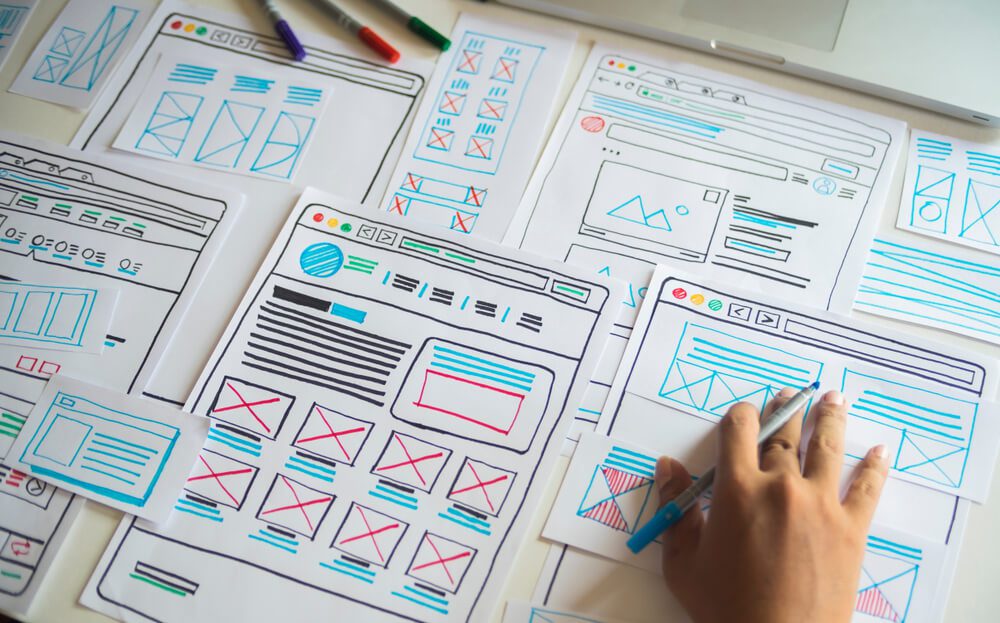
Why Are Wireframes an Important Part of the Best UX Designs?
Much goes into creating a user-friendly, functional app or website. A UX agency usually follows eight processes to develop a product that clients (and their users) will like. These include wireframing.
This blog post covers the basics of wireframing, especially its significant benefits to the entire UX design plan:
- Infusing a user-first approach to design.
- Promoting collaboration among stakeholders.
- Reducing app or website costs in the long run.
This article also discusses the definition of wireframes, how they differ from prototypes, and the best tips that agencies should follow. If you are ready to learn all these, read the article below. Let’s go!
To learn how Digital Authority Partners can create a standout website for you, watch this video!
What Are Wireframes?
Wireframes represent a product’s layout, structure, and functionality. They serve as a blueprint for the design process, helping designers, developers, and stakeholders understand and communicate the organization of content, navigation, and interactive elements on a webpage or application interface.
They are distinct from prototypes, although UX agencies commonly combine them into one development stage. Prototyping involves developing interactive models so that designers can test and evaluate user interactions, flows, and transitions.
In the process, they acquire meaningful feedback and uncover potential usability issues before launch. For this reason, teams create the wireframe before the prototype.
Wireframing also has three types:
- Low-fidelity is the simplest representation of a layout, focusing on the overall structure and organization of content. Models are often hand-drawn or made using basic digital tools. The purpose is to help teams visualize and test the project's early concepts, requirements, and design assumptions.
- Mid-fidelity has a more accurate layout than a low-fidelity wireframe. Although the model lacks images or typography to avoid distractions, features are more distinct. It is also useful for refining the design’s structure and flow.
- High-fidelity is the most detailed and advanced type of wireframe. It often contains actual content, typefaces, colors, image dimensions, and branding elements. This is often the basis for creating a prototype for user testing and feedback to evaluate the product’s overall user experience.
3 Huge Benefits of Wireframes in UX Design

Why do wireframes matter? These advantages explain their importance:
1. Infusing a User-First Approach to Design
The days when aesthetics took center stage in web and app design are gone. Sites such as Amazon or even Google have simple interfaces, but they work because they consider one crucial development aspect: the users.
Today, design is about creating meaningful, relevant user experiences. They must feel a connection or relate to the product if you want to attract their loyalty, encourage them to spend, or inspire them to share your app or website with others.
Wireframing helps you achieve all of these through:
- Increased clarity and efficiency.
- Content prioritization.
The level of visualization helps all stakeholders understand the project’s goal and direction. For instance, mobile app developers can reference wireframes to grasp each element's intended functionality and layout.
On the other hand, content prioritization helps you meet the user’s needs effectively and satisfactorily by:
- Identifying the key elements that are central to the user’s experience and goals.
- Allowing designers to experiment with their placement, considering their accessibility and ease of interaction.
For example, an ecommerce website might make the shopping cart and search bar prominent on the page. A news site might highlight headlines and article categories.
Content prioritization involves more than the prominence of elements. It is also about their logical flow. Designers should understand how a user would naturally navigate a page and arrange content to facilitate this journey.
2. Promoting Collaboration among Stakeholders
One of the leading reasons for app failures is a lack of effective collaboration. Wireframing avoids this by being a common visual reference for all involved.
Consider these:
- A product manager, UX designer, researcher, or developer creates the initial wireframe based on user research and business objectives. They then use it to present and discuss the application's or website's overall functionality, layout, and flow with the rest of the team. The client and other stakeholders can agree if the data is sufficient.
- Designers convene again after getting approval and use the wireframe as the blueprint for a more detailed mockup. By this time, they have considered the visual hierarchy, color schemes, typography, and other visual elements that would influence the user’s interaction with the product.
- Developers then step in, using the wireframes to understand the structure, functionality, and flow of the website or app. This enables them to effectively plan their code and element placements. During this phase, they often collaborate closely with designers to discuss potential technical constraints or propose alternative solutions.
- The best UX agency actively involves their clients, particularly the decision-makers, during wireframing and prototyping. They can provide feedback, request changes, or approve the plans before heavy coding starts. This early input saves significant time and resources, as wireframes are easier to alter than a complex coded design.
- In some cases, the users differ from customers, especially in B2B SaaS markets. The designers and the business leaders may bring in user representatives for early feedback from users or representatives. Having them onboard helps everyone more deeply understand user needs and expectations.
3. Reducing App or Website Costs in the Long Run
Tech startup costs can start at zero and skyrocket to millions in no time. To compete aggressively, many fledgling businesses become open to acquisitions and low interest but long-term loans instead of steady, slow, organic growth. The end result can include massive layoffs, among other negative outcomes.
Running and maintaining a platform or a site is expensive, so any way to cut costs is a huge win, particularly in uncertain and distressing times. One of these is to do wireframing.
From the get-go, creating wireframes is cheaper than designing a prototype immediately. However, it also effectively manages costs by:
- Clearly defining the project scope.
- Preventing scope creep, where additional features or changes are added mid-development, causing increased costs and delays.
- Addressing significant issues, such as accessibility or usability, before hard coding begins.
- Reducing the number of revisions required during the design and development process.
- Streamlining communication helps prevent misunderstandings that lead to costly errors or reworks.
Best Tips for Designing Wireframes

Designing effective wireframes requires attention to detail and careful planning. Here are some best practices to consider:
- Clearly define the objectives and identify user personas to tailor the wireframe to the target audience.
- Keep wireframes simple and low-fidelity to focus on structure and functionality rather than visual design. By stripping away distractions, designers can concentrate on the core aspects of the user experience and ensure a smooth user journey.
- Use annotations to explain interactive elements, intended functionalities, and specific UX considerations. They act as valuable guidelines for developers and other stakeholders to fully understand and implement the design.
- Balance creativity with structural requirements.
- Always consider accessibility and inclusivity during the wireframe design process.
Summing Up
Wireframing helps simplify a process as complex as UX design. As a master plan, it provides a clear project direction, ensures that the product matches the user’s needs, and promotes effective collaboration among the team.
Need help with wireframes? Digital Authority Partners (DAP), an expert UX agency, leverages the power of wireframing to design user-centric, efficient, and cost-effective digital experiences.
If you want to learn more about our process, contact us to schedule a free consultation.
Want To Meet Our Expert Team?
Book a meeting directly here




